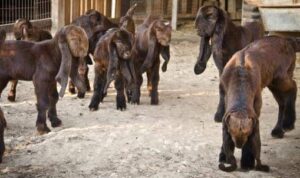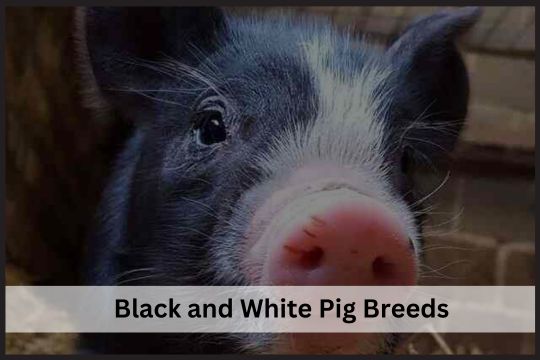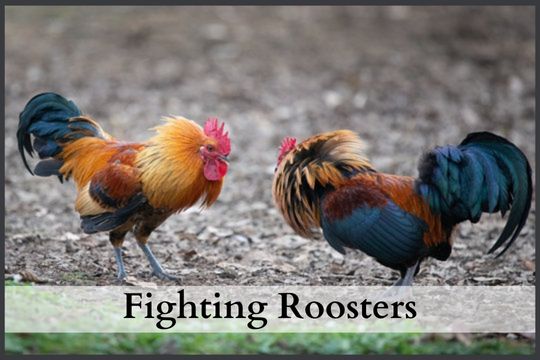Damascus Goat (Capra aegagrus hircus)
Damascus goat is the native breed of Syria (Al-Atiyat & Aljumaah, 2014) and other Middle East countries. As indicated by the name, this goat was supposed to be originated around Damascus, Syria (Zarkawi et al., 1999). After that, they are introduced to other countries like Egypt, Cyprus, Lebanon, Jordan, Algeria and Iraq. However, the name Damascus was given to them in Cyprus where they were brought by the British. It is mainly raised in Cyprus, Lebanon and Syria. It is also known by the name of Shami, Baladi, Halep, Allepo, Damascene or Chami. It is also known to be the ancestor of some Indian and Turkish dairy goat breed (Güney et al., 2006). This is a multipurpose goat raised for Milk, meat and hide. Due to its hardy nature, it can produce milk in changing environmental conditions and milk is rich in fat and protein which has made it popular throughout the Middle East. The name Damascus was also stated in many classics of Arabic literature. It was a noble breed that was also used to develop a new breed. There was a strange twist in appearance where the goat changes from the cutest one to what it has been called the ‘The Monoster’goat. Some often tag them as the bulldog of goats due to their appearance. Since the Damascus goat is typically different in appearance from other goat breeds, it can be easily identified and is gaining popularity throughout the world. This goat has interesting features. Let’s have look at them.
Breed characteristics

The body coat colour of the Damascus goat is reddish-brown and is rarely black which appears as a presence of recessive gene in the population (Mavrogenis et al., 2006). Some show silver-white, white, fawn and grey coat colour. The body is covered with long hairs. Sometimes white spots are seen on the body, legs and face. However, white spots are not common. It has long and pendulous ears measuring 27-32 cm in length. A long head and Roman nose with a long neck is a prominent characteristic. Long and fine neck is a good dairy character that is possessed by Damascus goat. Bucks are generally heavier and longer than the does which is natural as like that of other goat breeds. Adult live weight of about 65 kg for female and 75 kg for the male. Horns are either present or absent in both sexes. It is a large breed with a body circumference of 97- 99cm. Adaptation for high temperature and suitability for breeding in lowland areas is the most desirable feature of this breed (Tatar et al., 2019). Damascus goat has long protruding lower jaw that makes them difficult to graze and nurse.
Related Posts:-
Toggenburg Goat: Characteristics, Origin And Uses
Pashmina Goat: Origin, Price And Products
Breed Information
| Name Of Breed | Damascus |
|---|---|
| Native Place | Syria (Damascus,) |
| Other Names | Shami, Damascene, Halep, Aleppo, Baladi, Chami |
| Breed Type | Multipurpose |
| Breed Size | Large |
| Adult Male Weight | 70-90 Kg |
| Adult Female Weight | 50-60 Kg |
| Horn | Both Sexes Are Either Horned Or Polled |
| Coat Colour | Reddish Brown |
Reproductive Behaviours
Damascus goat is a seasonal breeder in which the breeding season starts from late August and extend to mid-December. At the age of 220 to 270 days, the first oestrus cycle occurs. However, it is dependent on the season of birth of the kid. The productive life initiates at the young age of 13 to 16 months. The fertility is considered to be medium to high as like of those other high milk yielding breeds. It is a highly prolific breed giving birth to 1.80 kids per kidding on average. Researches have shown that the twin percentage in Damascus goat is 50% but the does kids only once a year.
Breeding in Damascus Goat
Damascus goat breed only once a year. Mostly natural breeding is preferred. However, with the development of modern scientific breeding techniques, few commercial growers also carry out induced breeding. The breeding period is 36 hours long with a breeding cycle of 18 to 24 days. The gestation period is of 155 days which is similar to that of other breeds of goat (145-155). The lactation period is of 200 to 220 days. A healthy buck can breed 30 does. Mass mating, single mating and artificial insemination are commonly followed breeding methods of breeding.

Management System
The goat should be reared in the improved management system. Extensive grazing is not allowed and the goat can be successfully raised in both small and large-sized herds where the good provision of housing, feeding and other management issues are ensured. The common herd size for Damascus goats is 200-300 goats. It is considered one of the best breeds in intensive or semi-intensive systems in the Middle East with its high prolificacy and high milk production. Suckling duration, weaning time, energy and protein requirement of doe and kid and fattening practices are important management systems. Weaning can be immediately done after birth i.e. zero suckling or after six to seven weeks of birth. Weaning carried out at this time has no adverse effect on the growth of the kids.
Milk production
The does of Damascus goat are good milkers. The total milk yield was found to be 570 kg in one lactation period with an average of 1.9 kg per day (K., 2009). The milk of this goat is easy to digest and is found to be rich in fat and protein.
Meat production
Damascus goats are also reared for meat. As they have a high growth rate and they gain weight sooner than other breeds, they may fetch high returns to the growers.
Is the Damascus goat a real goat?
It is like the bulldog of goats and has an exceptionally short face and is much taller than the other goat breed. There is much difference between the kids (the baby of Damascus Goat) and grown-up goats. As compared to the kids matured goats are weirder. The kids have a normal face. However, in a later stage, they change from beautiful to a monster like face. Their look may scare many people as they have typically monster like face. They are adorable in young stage and on June 13 2008, a Damascus goat named ‘Qahr’ has received the ‘Most beautiful goat’ award in the Mazayen al-maaz competition held in Riyadh. The goats were judged on their overall appearance and rarity. Hardy in nature, Free from health hazards and high milk production are some factors for which the people love them despite their ugliest face.
Uses
This is a dairy goat breed. So, most probably they are raised for milk production in countries like Syria and Lebnan. However, they have many-fold uses. In some countries, they are also raised for meat and leather. With the growing popularity, they are often used in breeding to produce crossbred. Quick growth, higher twining percentage and adaptability to varied climatic conditions are the reasons for which the Damascus goat are used in crossbred with the other breeds of goats. Like in India, they are used for crossbred Boer and Sirohi goat. In some North American countries, this goat is also raised as pet animal.
Farming
Farming of Damascus goat is just like the other dairy goat farming. To start Damascus goat farming at first we have to purchase pure and healthy breed. Always buy the goat from a certified breeder and avoid buying the goat from an uncertified breeder because the health condition of a goat is of prime importance. Since these goats are larger, they require a large house for rearing. On average 15 square feet area per goat is sufficient. Proper ventilation should be ensured and the farm premises should always be kept dry and clean. Feeding is another important thing that should be carried out scientifically. Required doses of all the essential nutrients should be ensured through the diet. Feeding adequate green fodders enhance milk production. So, a sufficient amount of green fodder should be fed to the Damascus goat. Lucerne, Alfalfa, Berseem, Napier, Corn sillages, pellets etc should be included in the diet. For profitable farming, scientific breeding methods should be adopted. A healthy buck can mate up to 30 does. Additional care should be Pregnant does, breeding buck and also to the newborn kids. They should be fed with additional nutritious food. Timely vaccination is of great importance as it is beneficial in the sense that it reduces mortality and increase milk yield. All the equipment including milking machines should be cleaned well to avoid contamination. The doe should be milked twice a day. Keeping a veterinary doctor on the farm for regular check-ups has many fold advantages and a good market plan is of paramount importance for economic farming. Before starting Damascus goat farming, it is beneficial to visit a commercial farmer for knowing the characteristics of the breed and other systems of management.
Advantages
Damascus goats are advantageous in the following sense:
✓Multipurpose breed mostly raised for milk, meat and leather production.
✓Twinnig percentage is high 50% and may give birth to 3 to 4 kids in a single birth.
✓They have a high feed conversion ratio.
✓They are good milk yielders and milk is rich in fat and protein.
✓Hardy in nature and have wider adaptability in varied climatic conditions.
✓The weight of a 3-month kid ranges between 16 to 18 kg. Matured male goat may reach up to 90 kg if properly raised.
✓The average daily milk production is 1.9 kg.
✓It can be used in breeding to produce crossbreeds.
✓They have a high weight gain rate.
✓The average annual hair yield is 210 gm.
✓About in 450 to 500 days, female goats are ready for kidding.
✓They have a lactation period of 200 to 220 days.
Video On Viral Damascus Goat
Damascus Goat price
The price depends upon various factors. Generally, crossbreds cost low as compared to the pure breed. Crossbreed are inexpensive however a pure type breed of Damascus goat may cost 5000 us dollars.
Final Verdict
So, Damascus Goat is a gift of nature that shows unique variation in its appearance and is important in livelihood of Middle East People.
References
1.Al-Atiyat, R. M., & Aljumaah, R. S. (2014). Genetic relatedness between Ardi, Black Bedouin and Damascus goat breeds. Genet. Mol. Res, 13(2), 4654–4665.
2.Güler, Z., Keskin, M., Masatçioğlu, T., Gül, S., & Biçer, O. (2007). Effects of breed and lactation period on some characteristics and free fatty acid composition of raw milk from Damascus goats and German fawn x Hair goat b_1 crossbreds. Turkish Journal of Veterinary and Animal Sciences, 31(5), 347–354.
3. Güney, O., Torun, O., Özuyanık, O., & Darcan, N. (2006). Milk production, reproductive and growth performances of Damascus goats under northern Cyprus conditions. Small Ruminant Research, 65(1–2), 176–179.
4.Mavrogenis, A. P., Antoniades, N. Y., & Hooper, R. W. (2006). The Damascus (shami) goat of Cyprus. Animal Genetic Resources/Resources Génétiques Animales/Recursos Genéticos Animales, 38, 57–65.
5.Tatar, A. M., Tuncer, S. S., & Sireli, H. D. (2019). Comparison of yield characteristics of Damascus and Kilis goats in dry climatic conditions. Austral Journal of Veterinary Sciences, 51(2), 61–66.
6.Zarkawi, M., Al-Merestani, M. R., & Wardeh, M. F. (1999). Induction of synchronized oestrous in indigenous Damascus goats outside the breeding season. Small Ruminant Research, 33(2), 193–197.



Very informative and easy to follow